Late Summer/Autumn Lectures 2014
September 5, 2014 by admin
Filed under Garden Lectures
Friday, September 12
When: 10:30 am
Where: Grantham Town Hall, 300 Rte. 10 South, Grantham, NH
Monthly meeting of the Grantham (NH) Garden Club
Lecture: Shade Revealed: How to Garden Successfully in Low Light (Really!)
Thank you to the Grantham Garden Club for hosting this event.
Thursday, September 18
When: 6:00 pm
Where: The Whistler House Museum of Art, 243 Worthen St., Lowell, MA
This program is part of the annual Moses Greeley Parker Lectures series
Lecture: Shade Revealed: How to Garden Successfully in Low Light (Really!)
Thank you to the Moses Greeley Parker Lectures program and the Whistler House Museum of Art for organizing and hosting this event.
Monday, October 20
When: 7:00 pm
Where: Buchanan Center, Mansfield Public Library, 54 Warrenville Rd., Mansfield Center, CT
Combined meeting of the Garden Club of Windham and the Mansfield Garden Gate Club
Lecture: Shade Revealed: How to Garden Successfully in Low Light (Really!)
Thank you to the Garden Club of Windham and the Mansfield Garden Gate Club for hosting this event.
Plants Are Not Created Equal
March 12, 2014 by admin
Filed under Garden Design, Perennials, Regional Gardening, Shade Gardening
Over the coming months I’ll be basing a number of blog posts, including this one, on material from my forthcoming book, The Shady Lady’s Guide to Northeast Shade Gardening. The official publication date is May 6, 2014. You can learn more about the book here, here and here.
In my last blog post I talked about a process of elimination I think gardeners should use in order to choose perennial plants for their gardens and why I believe that process will result in the best choices. The rationale behind it can be boiled down to a few simple words: plants are not created equal—at least not from an ornamental gardening standpoint. Some are much better garden performers than others.
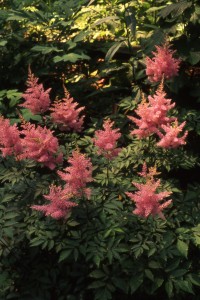
Astilbe is an excellent example of a backbone plant: it looks good all season and doesn't require tons of work.
It’s also important to realize that there’s no such thing as an ideal plant. You should no more expect perfection from a plant than a person, so you may have to give a little when it comes to your preferences.
Looking back at all the questions I said you should ask yourself when considering plants for your garden, I want to be clear that I’m not telling you there’s any plant for which all the answers will be what you want them to be. I’m just saying that for some plants a lot more of those questions have good answers, and those are the ones you should use to fill most of the space in your shade garden.
In fact, I have a name for these superior garden candidates: “backbone” plants. These are ornamentals whose exceptional qualities make them the best choices for filling the majority of the space in your garden. If you use them in abundance, they’ll hold your garden together and keep it solid, like a spine supports a body. Everything else, to one degree or another, is filler.
Strive to use backbone plants for at least 75-80% of your garden. Actually, you could build your garden from nothing but backbone plants, but for the sake of variety, you may allocate 15-20% of the space to secondary, filler plants that I refer to as “accent” plants. Finally, you can devote 5-10% of the space to a few annuals or tender perennials if you really feel the need to have them.
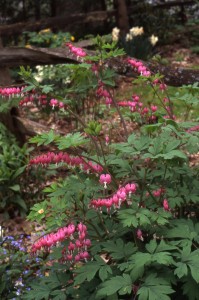
Old-fashioned bleeding heart is certainly a pretty face, but without staying power it doesn't qualify as a backbone plant.
So, what are some examples of backbone plants? I’ll give you two examples of backbone shade plants here, although this process of categorizing plants by their ability (or not) to deliver long-season performance applies equally well to sun as to shade.
The astilbe pictured above is a great example of a backbone shade perennial. It has strong, prominent flowers and attractive foliage, it’s not incredibly picky about growing conditions, it doesn’t require a lot of care, and it isn’t invasive. For those of us in the Northeast, its admirable cold hardiness is an essential quality, and the fact that deer generally ignore it is a godsend. Its only shortcoming is that it
really only flowers well in light shade at northern latitudes; in deep
shade, flowering will be minimal.
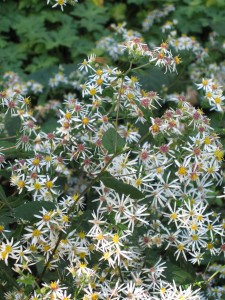
White wood aster is an underappreciated but very fine native backbone plant.
Plants like astilbe and white wood aster are reliable and unfussy—like friends who are easy to be with and always come through in a pinch. But you’ll notice that neither one gets “perfect marks.” As I pointed out earlier, it will almost never be the case that a plant perfectly suits all your needs and desires.
And they are not no-maintenance plants—there is no such thing in a garden setting. Each one has a rather predictable growth habit or behavior that will eventually demand your attention—astilbes often want division every few years, while white wood aster will migrate and have to be kept in bounds—but neither one will require an onerous amount of work. What they offer is a high likelihood of being successful additions to your garden, delivering steady results through the years while not making you regret ever planting them.
I know that this way of thinking about plants and plant selection may seem novel or even backwards to many readers. Gardeners are inundated with the message that gardening is all about personalizing your space and expressing your taste, not to mention the message that it should be cheap and easy, to boot (it generally isn’t, but that’s a topic for another blog post). While it’s certainly true that your garden should reflect your individuality, focusing too much on that obscures some inconvenient facts. Successful gardening means finding a manageable way to get good results given your budget of time and money, and for most homeowners that means putting functionality first.
I hope I’ve persuaded you of the value of using my approach. If you need a little more convincing, consider this: in the early years of my ornamental gardening experimentation, I bought a lot of plants I liked a lot and proceeded to…kill them. Mostly—because I was trying to determine the limits of their shade tolerance—I subjected them to inadequate light, and of course, a lot of them expired.
I feel kind of guilty about it now, but all that “horticide” did have a point: those sacrificial plants eventually taught me to categorize a wide range of shade perennials by both their needs and their performance potential for gardeners. In the process, I came to appreciate a whole new palette of plants for their ability to tough out the difficult conditions we Northeast shade gardeners face.
In my upcoming book, The Shady Lady’s Guide to Northeast Shade Gardening, I elaborate on the topic of what makes a superior shade garden perennial and how to use a wide range of shade plants to good effect. I hope that knowledge will help you find the best choices for your particular situation.
Lectures/Classes 2014
February 7, 2014 by admin
Filed under Garden Lectures
Wednesday, February 12
When: 9:30 am
Where: John Jay Homestead, 400 Jay St., Katonah, NY
Monthly meeting of the Bedford (NY) Garden Club
Lecture: Shade Revealed: How to Garden Successfully in Low Light (Really!)
Thank you to the Bedford Garden Club for hosting this event.
Thursday, February 13 (snow date February 20)
When: 1:15 pm
Where: St. Luke’s Church, 49 Turkey Hill Rd. North, Westport, CT
Monthly meeting of the Westport (CT) Garden Club
Lecture: Shade Revealed: How to Garden Successfully in Low Light (Really!)
Thank you to the Westport Garden Club for hosting this event.
Monday, March 10
When: 1:00 pm
Where: private home, New Canaan, CT
Monthly meeting of the New Canaan (CT) Gardeners
Lecture: Shade Revealed: How to Garden Successfully in Low Light (Really!)
Thank you to the New Canaan Gardeners for hosting this event.
Friday, March 21
When: 1:45 pm
Where: Lewis B. Rome Commons, University of Connecticut campus, 626 Gilbert Rd. Extension, Storrs, CT
UConn 2014 Garden Conference
Registration required; fee charged; visit the event registration web page for more information
Lecture: Shade Revealed: How to Garden Successfully in Low Light (Really!)
Thank you to the UConn College of Agriculture and Natural Resources Extension, the Ornamental Plant Extension Team, and the Home and Garden Education Center for organizing this event.
Wednesday, April 9 (snow date April 10)
When: 5:00 pm social; 6:00 pm lecture
Where: St. Mary’s Auditorium, 43 Foreside Rd., Falmouth, ME
Great Gardener Series fundraiser for St. Mary’s Garden Club
Tickets: $16 in advance; $20 at the door; visit the event web page for directions and more information
Lecture: Cottage Gardening: Adapting a Classic Garden Style to the Northeast
Thank you to the St. Mary’s Garden Club for hosting this event.
Saturday, April 12
When: 10:00 am
Where: White Flower Farm, 167 Litchfield Rd. (Rte. 63), Morris, CT
Registration fee: $15; advance registration requested. See the event registration web page for details
Lecture: Shade Revealed: How to Garden Successfully in Low Light (Really!)
Thank you to White Flower Farm for hosting this event.
Wednesday, May 14
When: 10:00 am
Where: Waveny House, 677 South Ave., New Canaan, CT
Monthly meeting of the New Canaan Garden Club
Lecture: Containers that Won’t Quit
Thank you to the New Canaan Garden Club for hosting this event.
How (Not) to Pick a Plant
February 6, 2014 by admin
Filed under Garden Design, Perennials, Shade Gardening
Over the coming months I’ll be basing a number of blog posts, including this one, on material from my forthcoming book, The Shady Lady’s Guide to Northeast Shade Gardening. The official publication date is May 6, 2014. You can learn more about the book here, here and here.
When you pick perennial plants to put in your shade garden, how do you do it? Most people would start out by picking plants they like—and that’s where they’d make their first, and worst, mistake.
Huh? What? Surely I can’t be advising you to pick out plants you don’t like?! No, of course not. But think about this for a second. When you go shopping for a new car, do you just pick out the one you like the best? No—at least not if you’re like most of us. If that were all it took, we’d all be driving around in Ferraris and Lamborghinis. The problem with that approach is that most sports cars won’t do what most people need a car to do: get up a snowy hill on a winter day and deliver you to your job in one piece, or get enough miles to the gallon to not break the fuel budget.
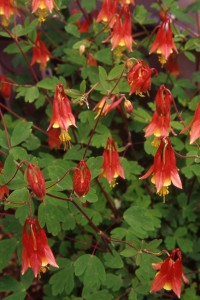
Flowers, flowers, we all like flowers—but there are many other important things to consider when choosing shade perennials.
In other words, we consider practical things. As weird an idea as this will seem to many people, you should do the same thing when you pick out plants—if you want your garden to look good with minimal effort and expense for the longest possible season.
Not all plants are equally good at doing that. In fact, for any given type of garden in any given region, only a small number of plants will give that kind of superior performance, in the same way that, in all likelihood, only a small number of cars will satisfy your criteria for budget and functionality.
So, what are the practical questions you have to ask when picking out plants? First, the more obvious ones:
• Is the plant cold hardy where I live?
• Does the plant prefer the conditions I can offer it?
It’s self-evident why these are questions you should ask first. It makes little sense to populate your perennial garden with plants that won’t be, well, perennial in your area. It also makes little sense to invest in plants that won’t be happy with the growing conditions you provide them. Matching plants to growing conditions is an essential part of the art of garden design. I’m not going to go into detail here about the fine points of that process; what matters is that you realize its importance.
What else do you need to ask yourself in order to pick the best perennials for shade? Here are a few more:
• Is the plant disease resistant?
• Is the plant prone to insect infestation?
• Is the plant unpalatable to deer and other potential browsers?
• Does the plant spread or seed aggressively?
• Does the plant typically go dormant before first frost?
• Does the plant have foliage that looks good all season long?
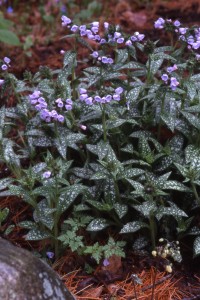
Powdery-mildew resistant Pulmonaria 'Roy Davidson'
The benefits of disease and pest resistance are obvious. Lungworts (Pulmonaria, see photo at left), for example, have unique speckled foliage that can brighten shady nooks and crannies, but most of them are prone to a disfiguring fungal disease called powdery mildew that leaves them coated with an unattractive whitish film. Luckily, some lungworts are resistant. If you buy only the resistant ones, you’ll be able to enjoy the beauty of disease-free lungworts, and you won’t have to expend extra effort to keep them that way.
It’s the same story for all the other questions above. By carefully selecting plants that aren’t palatable to most insect pests and browsing animals, you eliminate the need to take action to stop various critters from nibbling. Likewise, you reduce the need for work (and increase the percentage of your time in the garden devoted to enjoying it) by avoiding overly aggressive spreading plants.
Finally, as a general rule plants that perform well over a long season should be given priority over those that go dormant early or whose foliage declines in quality after flowering. Obviously, we’d all prefer a garden that looks full and good for the longest possible stretch of time.
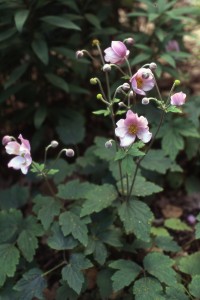
The long-flowering Japanese anemone cultivar 'Robustissima'
• Does the plant have attractive, prominent flowers? (Finally!)
• Do the flowers have a scent that’s nice, objectionable or simply absent?
• Do the flowers last a long time?
And there you have it: questions about flowers are in last place. Now, I want to clarify something. I understand perfectly why so many home gardeners give in to the temptation to fill their properties with plants having beautiful flowers. Beautiful flowers are lovely to look at—it’s as simple as that. The problem is that we don’t live in an ideal world. Flowers fade, and most perennials only produce flowers for two to three weeks every year under the best of circumstances. That’s not very long, so if you pick plants based on how well you like their flowers, you won’t get much bang for your buck.
I’m not saying that you should ignore a plant’s flowers when making choices. For instance, it is true that a small number of perennials will flower for a longer-than-average time, and can be worthwhile making room for these plants in your garden for that simple reason. One example is the Japanese anemone pictured above. I’m just saying that most of the time you should only be considering the flowers of plants that have passed muster in a lot of other ways first. Flowers should be your last consideration, not your first.
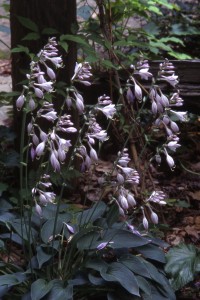
Cut these hosta flowers off? Not me!
In my next blog post, I’ll elaborate a little more on what makes a superior shade perennial and share a few examples.
A Spring Thing: Flowers in the Shade
May 31, 2009 by admin
Filed under Garden Design, Shade Gardening
Here we are at the start of June. By the time summer arrives in three weeks, the majority of perennials in northern shade gardens will already have finished blooming. Is that surprising? You may never have realized it, but most shade tolerant perennials bloom in spring.
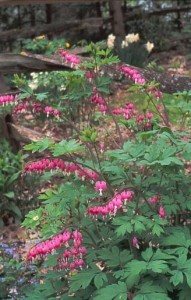
The dangling pink hearts of Dicentra spectabilis are just a memory by the start of summer.
Think about it: hellebore, lungwort, violet, nodding mandarin, epimedium, Solomon’s seal, old-fashioned bleeding heart, most primroses, globeflower, Siberian bugloss, twinleaf, woodland phlox and many other shade standards are already done flowering. False Solomon’s seal, rodgersia, columbine, spotted geranium, bigroot geranium and mayapple are in bloom now, but they’ll be finished by late June, too. Foamflowers are fading (although if deadheaded they’ll put up more flower stalks), and the fruits of baneberry and goldenseal are already fattening up! Yup, flowers in the shade are mainly a spring thing.
What’s left to please the eyes of shade gardeners through the coming months? Goatsbeard, astilbe, hosta, bugbane, Japanese anemone, toad lily and woodland aster are all yet to come. There are more, of course, yet the fact remains that most shade perennials bloom very early in the year. I’d guesstimate 75% of them have wrapped up their flowering by the summer solstice.
There’s a good reason for that, of course. We tend to forget that plants don’t flower to please us. They have their own agenda: reproduction.
In our mostly deciduous temperate forest, the woodland is a full sun environment from November through April when the leaves aren’t on the trees. Most of that time, it’s too cold for perennials to grow, but in March and April, it’s just warm enough for them to shoot up quickly and do energy intensive things like flowering and setting seed while there’s plenty of sunlight to fuel the process. When the trees leaf out in May, many woodland perennials are winding down and looking forward to doing what we all would do if we could get away with it: lounging about all summer.

The best foliage plant ever? Hosta.
The tendency of woodland plants to flower in spring is the main reason why shade gardeners are often advised to stop focusing on flowers and instead rely heavily on exceptional foliage plants: ferns, hostas, sedges, and variegated plants such as (to name just one example) Brunnera macrophylla ‘Variegata’. Flowers will come and go in weeks, but foliage is season long.
Annuals can also help keep color going through the warm months, but the choices for shade in the north are severely limited. Begonias and impatiens are two obvious answers, and they’re readily available at low cost. Gardeners who have grown bored with wax-leaf begonias can try the dragon-wing types for some variety. These grow larger than wax-leaf begonias, are extremely floriferous and make more of an impact, but they also cost more since they aren’t available in 6-packs but have to be purchased in 4-inch pots.
Caladiums are another great choice for summer color in shade gardens, although once again the color is coming from leaves, not flowers. Caladiums are not cold hardy in the North and won’t survive winter in the ground, but they can be dug and stored, dormant, and regrown the following year if you have a bright, warm spot to start them indoors beginning in February or March. Be sure not to put them in the garden too early because they are very sensitive to cool nightime temperatures. Even here in southern New England, I’ve learned not to plant them outdoors until the first week of June. If you do get ahead of yourself with caladiums and they get whacked by an extra-cold night, they should spring back quickly as the weather warms even if their foliage dies back completely in the interim.
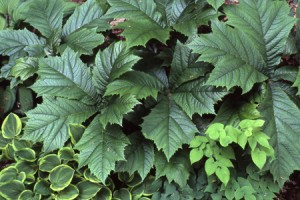
After their flowers have faded, rodgersia and epimedium leaves will continue to bring beauty to the shade garden.
Don’t forget that lots of those spring blooming shade plants I mentioned earlier also have great foliage that will contribute to the beauty of your garden right up until the first frost. Rodgersia, epimedium, hellebore, Solomon’s seal and twinleaf are just a few examples of plants that would be worth growing even if they didn’t flower! So, when designing your shade garden, consider each plant’s total contribution to the effect through the whole growing season, not just the loveliness of its flowers, its most ephemeral aspect.
Spring Blooming Shade Plants: Hellebores
March 18, 2009 by admin
Filed under Perennials, Shade Gardening, Spring Bloomers
In a typical year, hellebores will be the first ornamental perennial to bloom in the Northeast. Although there are several species that can be grown in this region, especially in milder areas such as the coast and the lower Connecticut River Valley, one of the hardiest remains my favorite: Helleborus x hybridus (formerly and sometimes still known as Helleborus x orientalis).
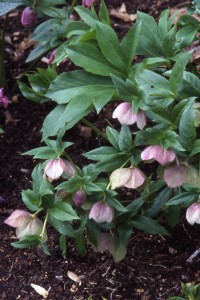
Helleborus x hybridus
Here in northwest Connecticut, hellebores send up their flower buds first, in March, before their leaves unfurl. As the month goes on, these succulent and tender looking shoots grow taller and taller, until they finally open up around April 1 to reveal clusters of 2″-wide, pendant blossoms. The species H. x hybridus is quite variable, with a range of subtle flower colors including creamy white, apple green, pale pink and burgundy. Its flowers often have striking speckled markings and prominent yellow anthers that are showy for about a week until the stamens fall off.
At first, hellebore flowers look a bit undressed because the plant’s leaves don’t come along until a few weeks later. When they do make their appearance, however, they are exceptionally attractive—leathery, glossy, palmate (arranged like fingers around the palm of a hand) and semi-evergreen.
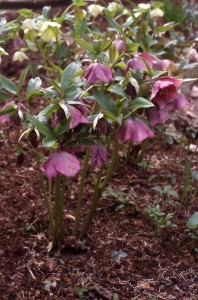
Hellebore flowers emerge before leaves
Everything about hellebores is long lasting. Instead of dropping off after 2-3 weeks, hellebore flowers slowly fade to a pale green or buff color in much the same way hydrangea flowers do. They look good (although subdued) right up to the point when the seeds mature and are dispersed, usually in the latter half of June. Deadhead them before that point unless you want seedlings the following spring. In most gardens, the leaves will remain disease free and unblemished all season long, and will still be looking good when the first snow flies.
Shade tolerance: High
Hardiness: Zone 5; other species may differ
Size: Medium sized, with a height and spread of 15-18″
Native status: non-native to any part of North America
Growing Tips
- Don’t cut back hellebore foliage in fall, even if you clean up the rest of your garden then. Why? Hellebores come up so early in the year, they are subject to damage from late frosts. These frosts won’t kill the plants, but they will kill the flower buds. As the plant’s shoots begin to emerge from the ground, last year’s leaves will provide some protection. After the new shoots have grown taller than last year’s leaves, you can groom them, cutting off the old foliage at ground level. Be careful not to accidentally cut off new growth—it’s easy to do. For a few more weeks after you groom them, it’s a good idea to keep some pine boughs or an equivalent handy to gently arrange over the new growth at night if a hard frost is in the forecast.
- Hellebores have to be several years old before they are mature enough to flower. A nursery plant in a 5-pint pot is probably only two years old, so don’t be surprised if it doesn’t flower its first (or even second) year in the ground. As long as the plant grows well and looks healthy, flowering should start when the plant is ready. A plant that fills a one-gallon pot should be old enough to flower its first spring after planting.
- H. x hybridus is often sold in a mix of undifferentiated colors. In other words, if the tag in the pot with your plant does not specify a flower color, but just says H. x hybridus, it could be any of the flower colors listed above. There’s no way to know which color you’ve got unless you buy the plant in bloom very early in the season and the plant is old enough to be blooming in the first place. In recent years, some growers have also offered hellebores in designated colors. I like the way the mixed colors look in the garden when hellebores are massed, but gardeners with color-theme gardens might prefer to purchase all of one kind.
- Hellebores have no special needs, but they don’t like excessive moisture. If put in exceedingly dank locations or planted in soils that drain poorly, rot of the crown may result.
- Hellebores self-sow moderately. Their seeds are large and heavy, so they don’t usually travel very far. If you don’t deadhead your plants before they drop their seeds, you’ll probably find a “skirt” of seedlings around their feet in spring. Move these to a nursery bed to mature or give them away to friends.
Bloom times and other life cycle stats are accurate for northwest Connecticut. In milder areas all aspects of a plant’s life cycle may occur earlier in the year, and in colder areas, later.

